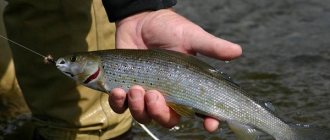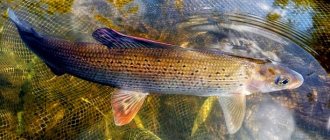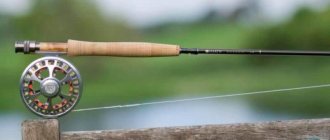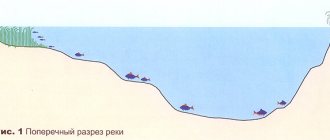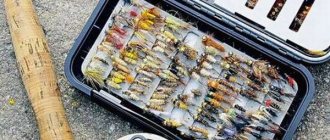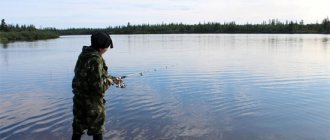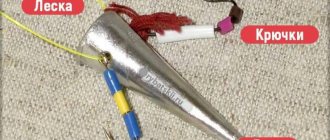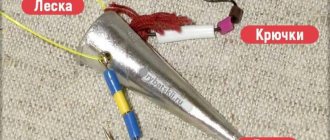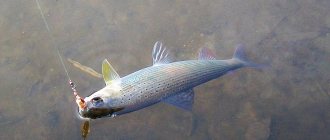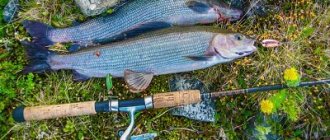Peculiarities of catching grayling on a bulldozer
Fishermen have been using the bait, which has the very ambiguous name “bulda,” for a long time. This tackle gives good fishing results both in winter and summer. In the district of the Yamalo-Nenets Autonomous Region, since time immemorial, there has been such a float rig, where several leashes with artificial flies are attached to the main line slightly above the float. In the Komi Republic, when hunting grayling, they used similar equipment, which made it possible to cast without overlap over very long distances. This kind of tackle is called “balda” or “yalda”, although other local names are possible.
How to make Balda at home
The Siberian variety of donka demonstrates stable catchability on rivers with moderate and fast currents, as well as any type of bottom. Ready-made options do not always correspond to fishing conditions. A natural question arises: how to make a balda yourself.
The equipment includes two main components: 1. A weight of a cone-shaped, pear-shaped or elongated shape. It is usually made from lead. Modern fishermen prefer to buy a finished product, since they need to melt lead themselves in air (the material is toxic). Sometimes bronze is used instead of lead: according to reviews, such a weight, when tapped on the bottom, creates more noise than attracts grayling.
If you want to make a sinker at home, you will need a casting mold. The material is usually plaster or wood.
On the Angara and Yenisei, local fishermen use a very original sinker, consisting of two parts. The lower one is made of lead, the upper one is made of cedar cones, through which the setting line is passed. What is the sacred meaning of the cone? Everything is very simple. In water, such a load stands vertically in relation to the bottom, significantly reducing the likelihood of the gear getting stuck between rocks. If such a nuisance does occur, by pulling the line harder, you can cut the cone and pull out the tackle.
How to choose a bullhead for grayling fishing
Nowadays, grayling fishing has become popular everywhere. This simple gear is in the arsenal of most “silent hunting” lovers. When choosing a float, you need to understand that it is essentially a self-submersing float weighing up to 100 g and up to 12 cm long. It can be made of wood or dense foam. A lead weight weighing up to 50% of the entire float load is attached to the bottom. In the center of the float there is an inclined hole through which the fishing line is passed and tied to the ring. On a two-meter spinning rod you need to use 2 leashes (one 10 cm long and the other 15 cm long). They must be 20 and 50 cm away from the bulldozer. The main line must have two stoppers made of beads, and between them there is a fixed button with holes for the line and leash. Leashes can be equipped with a variety of flies.
Depending on the time, place and fishing conditions, you can choose from three varieties of bullhead that are common in our country. Firstly, this is a classic bulldozer used in winter. This is a drop-shaped weight with a loop of fishing line on which a pair of hooks with beads are fixed. On the rivers of Siberia, you can use a classic bulldozer with a so-called post (or setup), that is, a piece of fishing line with several leashes. And another variety is a large float of a composite structure (wooden or foam top and lead bottom). This device is convenient to use when fishing for grayling on the surface.
When fishing for grayling on a bulldozer, sinkers of various configurations are used. They can be either pear-shaped or elongated. A thin and elongated sinker has a certain advantage. The fact is that it can easily be adjusted to a float in specific conditions. This is done with the help of wire cutters, which can be used to reduce it to the desired weight right while fishing.
Balda tackle device
The winter bait "Balda" has a reputation for being catchy and is used for catching predatory fish. With its help they hunt mainly for perch and grayling, but ruff, pike perch, pike, and sometimes bream and roach are also caught on the hook.
In its classic form, the design of the gear is as follows:
- A drop-shaped lead sinker with holes in the top.
- A fishing line threaded through the holes with a non-tightening loop.
- Two hooks on a fishing line, the tips of which are directed in the opposite direction from the sinker.
- Black, yellow or red cambrics for decorating hooks. They may be of a different color.
To better attract fish, the sinker is painted green, brown or black, and its lower part is painted red. But lead doesn’t hold paint well and after just a few fishing trips it falls off.
Fishermen have been using Balda for decades. During this time, the tackle was changed and modified. Today there are several varieties of Balda:
We also recommend reading:
Budget spinning reels Riobi Exiya Features of crucian carp killer gear and how to make such equipment Diagram of how to learn how to tie a hook to a fishing line Features of fishing with a retractable leash, selection of gear and installation
- The grayling boom or riding bait differs from the classic bait in its float, which is made of two parts. The first of them is loaded with lead, and the second is made of foam or wood and floats on the surface. Flies are attached to leashes and the bait is sent downstream. It is necessary to ensure that it is on the surface at all times.
- The Siberian Balda consists of a bottom part, which is a classic bait, and a top bait or column. This is a piece of fishing line with leashes. A hook with a fly or beads is attached to each leash. The post is connected to the fishing line using a carabiner. A massive float is put on the fishing line, which ensures the movement of the bait with the current and signals a bite. If necessary, you can tap the bottom with a Siberian Balda. This gear option is used in the warm season.
Grayling fishing technique
The technique of catching grayling on a bulldozer is not complicated, but it requires fairly good physical preparation. Let's consider its features. The first requirement: the tackle must be cast as far as possible from the shore and upstream, the sound of the float splashing down must be quiet. To achieve this immediately, the weight of the sinker on the leash must be proportional to the casting distance. The current will carry the bulldozer down 100 meters, after which we begin to pull it back. It will slowly move along the bottom, raising mud, and the flies on the leashes will move. This is what attracts fish. Please note that the equipment should under no circumstances be twisted or overlapped with the main line. After casting the bait with a fishing rod, this tackle should stand vertically. Maintain this position under all conditions, regardless of the strength of the current and the length of the stretched fishing line. Verticality will ensure uniform and symmetrical vibrations of the hooks. Namely, these movements, similar to the movements of various aquatic life that rush to the surface, work for the catch. By tapping the bottom with the tackle, it is advisable to raise silt or sand. In such turbidity, grayling will definitely mistake the moving bait for live food.
Installation of equipment
Whatever shape the fisherman chooses, to install the equipment you will need:
After all the components are prepared, you can begin assembling the donkey.
Installation of the bulldozer (Tyrolean stick - one of the types of sinkers) Advice! The main thing in fishing with a bulldozer is the correct wiring. When installing the equipment, you need to prepare a sufficiently large supply of flies of different weights on short leashes with a loop. The bait should move quite slowly relative to the bottom, cushioning it on the thread. If the nozzle sags, it must be replaced with a lighter one.
Catching grayling on a balda is interesting, but the method requires appropriate skill. The correct choice of float and weight, the ability to configure them to work in pairs and properly prepare the equipment is an important step towards a decent catch.
Source
Fishing for grayling on balda in summer and winter
They catch grayling on the bait both in summer and in winter. But, according to many, winter fishing is more catchy, although summer fishing is also successful. Summer fishing for grayling on baldu begins after spawning. Usually a fishing rod is used, the length of which is about 6 m. It is impossible to say exactly the length of the fishing rod, since it all depends on the width of the river. Experienced fishermen advise removing the tulip from the rod, in which case unrealized bites will be minimized. The fact is that the soft tip cannot hold the fish, and most of the fish will go away. The boom itself should be quite heavy in order to attract grayling by knocking on the bottom. You can fish with this bait in the summer both from the shore and from a boat. If you are fishing using a watercraft, the process will be carried out vertically. Lower the bait to the bottom, raising the turbidity, then the fish will definitely be interested in it. In winter, it is best to catch grayling on a balda during the first ice period, when the fish are hungry and take any bait, although later in large flowing reservoirs you can also successfully use it. When using a balda, you do not need to constantly clean the hole, because crushed ice will not interfere with vertical wiring. And thanks to this, you can successfully catch grayling even in the shallows.
Winter is the season for experimenting with the size of the sinker and the color of the beads on the hooks. When fishing, you can use pieces of silicone, artificial bloodworms, some even use a jig. With all this, we must not forget about the periodic renewal of bait, which must be placed in the hole. Then the fish will not leave the feeder and will continue to actively bite on the bulldozer.
Running donka. Device
A running donka can be a completely homemade tackle. Starting from the rod and reel, right down to the float, sinker and flies. Such gear was manufactured at numerous military factories - these were titanium or duralumin blanks and homemade inertial reels on bearings.
Now almost all components of this equipment can be purchased in stores. However, many anglers make their own floats and sinkers, not to mention homemade fishing flies.
A modern running donka (balda) includes:
- the actual spinning rod (blank) with a test weight of 40-80, quite rigid, plug-in or telescopic, from 2.5 to 4.5 meters long, with rings of increased diameter;
- inertial coil on bearings, with a diameter of 120-180 mm, or an inertia-free coil, class 2500 and higher;
- monofilament line 0.3-0.5 mm, or braided line, 100-200 m long;
- movable limiter - float stopper;
- large foam float with beads;
- top swivel;
- leash (post, setup), 1.0-1.5 m long, only made of mono fishing line with knots or loops for attaching 2-3 flies;
- lower swivel with clasp or winding ring;
- streamlined sinker - homemade from lead or other metal weighing from 30 to 90 g.
When fishing with braided fishing line, problems arise with the limiter, which are solved by installing a shock leader made of monofilament 20 meters long.
Where to catch grayling on bulldozer
At all times, the main thing for a fisherman was to find active prey. Large and small rivers, flowing reservoirs, all this is a real paradise for those who like to fish for grayling. One of the main factors is the presence of a strong current. You need to choose sections of the riverbed where there are riffles or edges. If the river is wide, then grayling will be found relatively far from the shore, choosing deep places. He likes to choose sites near rocks and rapids, but at some distance from the rapids, where the water foams.
Catching grayling on a bulldozer is not difficult if you know certain secrets and have the skill of reading a book called “Nature”. Don’t be surprised if, in addition to grayling, you catch other representatives of the predatory underwater tribe. After all, not every fish can resist the bully that moves so appetizingly in the water column.
Types of gear for fishing grayling
The fish called "Grayling" belongs to the salmon family. A distinctive feature of this species is the presence of a large dorsal fin, which in males can reach the base of the caudal fin.
Particular attention should also be paid to the coloring: a dark gray back, in some cases, dark spots of various shapes and sizes form on the sides. Habitat: mountain rivers that have cold and clean water.
Often this fish can be caught in oligotrophic lakes in mountainous areas. Food can include aerial insects in warm weather, mayflies, brook larvae, and in some cases, other small fish. Grayling is caught with a fly.
